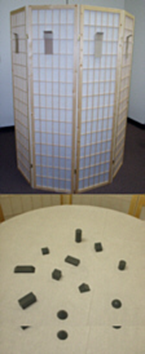Mental Imagery and Human-Computer Interaction Lab
Spatial Updating
 Spatial updating refers to the cognitive process that compute the spatial relationship between an individual and his/her surrounding environment as he/she moves based on perceptual information about his/her own movements. It is one of the fundamental forms of navigation, and it contributes to object and scene recognition by predicting the appearance of objects or scenes from novel vantage points so that the individual can recognize them easily as he/she moves.
Spatial updating refers to the cognitive process that compute the spatial relationship between an individual and his/her surrounding environment as he/she moves based on perceptual information about his/her own movements. It is one of the fundamental forms of navigation, and it contributes to object and scene recognition by predicting the appearance of objects or scenes from novel vantage points so that the individual can recognize them easily as he/she moves.
In our research (Motes, Finlay, & Kozhevnikov, 2006; Finlay, Motes, & Kozhevnikov, 2006) we systematically compared scene recognition response time (RT) and accuracy patterns following observer versus scene movement across view changes ranging from 0 to 360 degrees. The results demonstrated that regardless of whether the scene was rotated or the observer moved, greater angular disparity between judged and encoded views produced slower RTs. Thus, in contrast to previous findings which did not consider a wide range of observer movement, our data show that observer movement does not necessarily automatically update representations of spatial layouts in small-scale (room-sized) environments and raise questions about the effects of duration limitations and encoding points of view on the automatic spatial updating of representations of scenes.